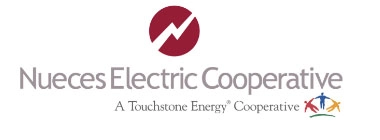You know electricity gets to your home, because when you flip the switch your lights come on. But you may not understand how. The process is quite complex yet a very systematic step process.
With the addition of renewable energy into the modern electric grid, the landscape of electric generation, transmission and distribution is on the brink of change. Your electric cooperative continues to monitor changes in technology and continuously adapts our process to ensure we are bringing every member reliable, cost efficient, electric service.
- Power plant – Electricity starts here, produced by spinning generators that are driven by water, a diesel engine, or a natural gas or steam turbine. Steam is made by burning coal, oil or natural gas or by a nuclear reactor. When needed, extra power is brought into an electric system from plants outside the area. NEC is fortunate to own our power plant, or generation resources. STEC (South Texas Electric Cooperative)(link is external) provides electricity to seven south Texas distribution cooperatives. STEC uses a variety of generating sources including: coal, hydro, natural gas, and wind.
- Power grid – Electricity is carried over a network, or "grid," that connects power plants to a substation and from there to distribution lines that take the power to homes or businesses. The Texas power grid system is managed by the Electric Reliability Council of Texas, or ERCOT(link is external), All electricity generated in Texas goes to the Texas grid no matter where, or how, it was generated.
- Transmission substation – These facilities look like giant erector sets connected to wires from the power plant. Here large transformers increase voltage from thousands to hundreds of thousands of volts so the power can be sent over long distances.
- Distribution Substation – You see them around towns and cities. They are those small fenced-in areas that have electric lines coming in and going out. Inside these fenced-in areas are transformers that reduce voltage to a lower level so the power can be sent out on distribution lines to the surrounding community.
- Distribution system – Includes main or primary lines and lower voltage or secondary lines that deliver electricity through overhead or underground wires to homes and businesses. You see these lines every day on poles alongside roads and streets. NEC delivers power to members-owners through a vast network of 3,200 overhead and underground power lines.
- Service connection – That’s the line that connects to the meter on the side of homes and businesses. The meter is used to determine how many kilowatt-hours are used by each customer.
NEC Member Benefits
As a member of Nueces Electric Cooperative (NEC) you are an owner of YOUR Cooperative! NEC isn’t like other utilities where you are “just another customer.” At NEC, as a member-owner-consumer, we work for and we’re accountable to you. We operate on a not-for-profit basis so we aren’t trying to make a large profit to give to stockholders who may or may not receive our services. We continually look out for the best interests of all of our members and we work every day to manage our costs so your electric bills stay fair and reasonable. We operate under the guidelines of the Seven Cooperative Principles, and our values reflect our accountability, and our commitment to reliability, innovation, and our members’ communities. Other benefits of membership in NEC are…
Capital Credits- profits or margins returned to member- consumers
Texas Co-op Power Magazine- monthly publication include electric safety tips, energy efficiency tips, important co-op happenings, and member features.
Annual Membership Meeting-you Are An owner of NEC so be sure to attend this meeting each year.
Automatic Bank Draft- a convenient bill payment option
Operation Round-Up- volunteer to round-up your bill to the next dollar to help HALO-Flight Air Ambulance Service
Level Billing - let us help you better budget for your electric bills
Security/Floodlighting
Energy Audits/High Bill Consultations
NEC Education Fund Scholarships - for high school seniors
Youth Tour Essay Contest - for high school juniors



 Member
Member